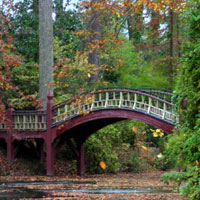Testing the Waters in College Creek
Water runs under the bridge at Crim Dell, then where does it go? And what’s in that water, anyway?
 These are questions often posed by students, faculty and staff
at William & Mary and also the sorts of water-quality questions
asked by homeowners throughout the College Creek watershed—the local
drainage basin for the College and surrounding land in Williamsburg and
James City County.
These are questions often posed by students, faculty and staff
at William & Mary and also the sorts of water-quality questions
asked by homeowners throughout the College Creek watershed—the local
drainage basin for the College and surrounding land in Williamsburg and
James City County.
Until recently, no one has known what’s in the water in local streams, lakes and tidal creeks that drain into College Creek. In 2004, as part of a summer research program at the W.M. Keck Environmental Field Laboratory, a group of students assumed responsibility for monitoring water quality in local waterways. They created the College Creek Alliance to promote watershed stewardship and education through the collective actions of people in the community and at the College.
With Keck Lab director Dr. Randy Chambers, the students collect and analyze water samples from 23 locations around the 14 square-mile watershed. They measure temperature, pH, dissolved oxygen, dissolved solids, turbidity, nutrient concentrations and fecal coliform levels. The collections are completed four times a year to track seasonal variations and to detect hotspots for poor water quality.
So what really is in that water running under the Crim Dell bridge? The students have measured low levels of dissolved oxygen (the reason why the College installed bubblers at the bottom of Crim Dell to oxygenate the water), and high levels of dissolved nutrients (likely a consequence of fertilizer runoff from campus lawns). On some sampling dates, fecal coliform levels have been above state-mandated standards to permit reasonable public use of the water (swimming and fishing).
Crim Dell water flows downstream through campus and into Lake Matoaka. In turn, lake water spills over the dam on Jamestown Road and into College Creek, which empties into the James River, and finally into the Chesapeake Bay. So like all 23 locations comprising the streams, lakes and tidal creeks in our local watershed, Crim Dell is connected to the Bay.
Declining water quality in the Chesapeake Bay is a downstream reflection of what is delivered from upstream, but how many people make the connection between watershed land use and the health of the Bay? To address this issue, College Creek Alliance (CCA) students designed a survey of local perceptions of water quality. Parents of middle school students completed the survey and the results were somewhat surprising. A majority of over 200 survey respondents did not even know that their homes in Williamsburg/James City County were part of the Chesapeake Bay watershed.
This disturbing result highlights the need for more community-based environmental education to help residents understand the potential impacts of their local actions on the region. In coming years, the College Creek Alliance will continue monitoring local water quality and develop community-based initiatives to involve both students and townspeople in promoting watershed education.
This article appeared in the Spring 2006 issue of our newsletter, Downstream.
 Skip to main content
Skip to main content
